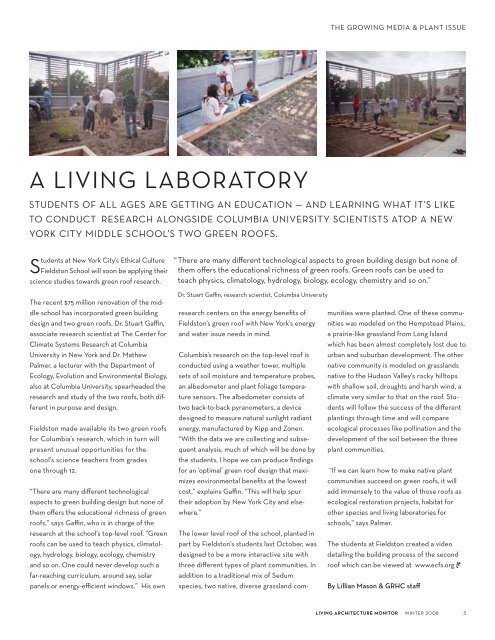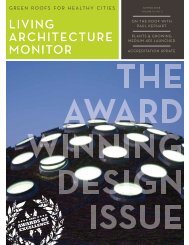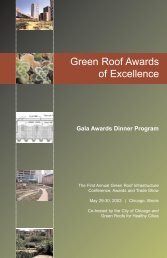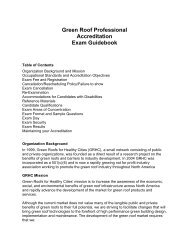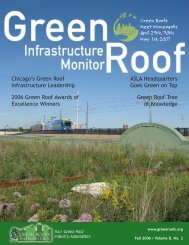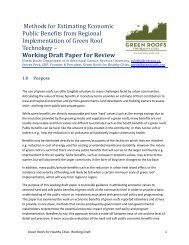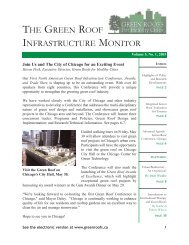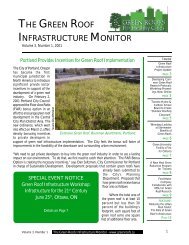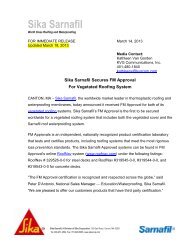Living Architecture Monitor - Green Roofs for Healthy Cities
Living Architecture Monitor - Green Roofs for Healthy Cities
Living Architecture Monitor - Green Roofs for Healthy Cities
Create successful ePaper yourself
Turn your PDF publications into a flip-book with our unique Google optimized e-Paper software.
THEGROWINGMEDIA&PLANTISSUE<br />
ALIVINGLABORATORY<br />
STUDENTSOFALLAGESAREGETTINGANEDUCATION—ANDLEARNINGWHATIT’SLIKE<br />
TOCONDUCTRESEARCHALONGSIDECOLUMBIAUNIVERSITYSCIENTISTSATOPA NEW<br />
YORKCITYMIDDLESCHOOL’STWOGREEN ROOFS<br />
Students at New York City’s Ethical Culture<br />
Fieldston School will soon be applying their<br />
science studies towards green roof research.<br />
The recent $75 million renovation of the middle<br />
school has incorporated green building<br />
design and two green roofs. Dr. Stuart Gaffin,<br />
associate research scientist at The Center <strong>for</strong><br />
Climate Systems Research at Columbia<br />
University in New York and Dr. Mathew<br />
Palmer, a lecturer with the Department of<br />
Ecology, Evolution and Environmental Biology,<br />
also at Columbia University, spearheaded the<br />
research and study of the two roofs, both different<br />
in purpose and design.<br />
Fieldston made available its two green roofs<br />
<strong>for</strong> Columbia’s research, which in turn will<br />
present unusual opportunities <strong>for</strong> the<br />
school’s science teachers from grades<br />
one through 12.<br />
“There are many different technological<br />
aspects to green building design but none of<br />
them offers the educational richness of green<br />
roofs,” says Gaffin, who is in charge of the<br />
research at the school’s top-level roof. “<strong>Green</strong><br />
roofs can be used to teach physics, climatology,<br />
hydrology, biology, ecology, chemistry<br />
and so on. One could never develop such a<br />
far-reaching curriculum, around say, solar<br />
panels or energy-efficient windows.” His own<br />
“ There are many different technological aspects to green building design but none of<br />
them offers the educational richness of green roofs. <strong>Green</strong> roofs can be used to<br />
teach physics, climatology, hydrology, biology, ecology, chemistry and so on.”<br />
Dr. Stuart Gaffin, research scientist, Columbia University<br />
research centers on the energy benefits of<br />
Fieldston’s green roof with New York’s energy<br />
and water issue needs in mind.<br />
Columbia’s research on the top-level roof is<br />
conducted using a weather tower, multiple<br />
sets of soil moisture and temperature probes,<br />
an albedometer and plant foliage temperature<br />
sensors. The albedometer consists of<br />
two back-to-back pyranometers, a device<br />
designed to measure natural sunlight radiant<br />
energy, manufactured by Kipp and Zonen.<br />
“With the data we are collecting and subsequent<br />
analysis, much of which will be done by<br />
the students, I hope we can produce findings<br />
<strong>for</strong> an ‘optimal’ green roof design that maximizes<br />
environmental benefits at the lowest<br />
cost,” explains Gaffin. “This will help spur<br />
their adoption by New York City and elsewhere.”<br />
The lower level roof of the school, planted in<br />
part by Fieldston’s students last October, was<br />
designed to be a more interactive site with<br />
three different types of plant communities. In<br />
addition to a traditional mix of Sedum<br />
species, two native, diverse grassland communities<br />
were planted. One of these communities<br />
was modeled on the Hempstead Plains,<br />
a prairie-like grassland from Long Island<br />
which has been almost completely lost due to<br />
urban and suburban development. The other<br />
native community is modeled on grasslands<br />
native to the Hudson Valley’s rocky hilltops<br />
with shallow soil, droughts and harsh wind, a<br />
climate very similar to that on the roof. Students<br />
will follow the success of the different<br />
plantings through time and will compare<br />
ecological processes like pollination and the<br />
development of the soil between the three<br />
plant communities.<br />
“If we can learn how to make native plant<br />
communities succeed on green roofs, it will<br />
add immensely to the value of those roofs as<br />
ecological restoration projects, habitat <strong>for</strong><br />
other species and living laboratories <strong>for</strong><br />
schools,” says Palmer.<br />
The students at Fieldston created a video<br />
detailing the building process of the second<br />
roof which can be viewed at www.ecfs.org <br />
By Lillian Mason & GRHC staff<br />
LIVING ARCHITECTURE MONITOR WINTER


